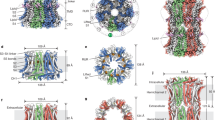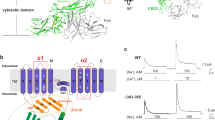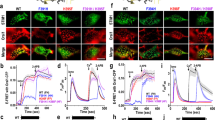Abstract
The calcium release activated calcium channel is activated by the endoplasmic reticulum-resident calcium sensor protein STIM1. On activation, STIM1 C terminus changes from an inactive, tight to an active, extended conformation. A coiled-coil clamp involving the CC1 and CC3 domains is essential in controlling STIM1 activation, with CC1 as the key entity. The nuclear magnetic resonance-derived solution structure of the CC1 domain represents a three-helix bundle stabilized by interhelical contacts, which are absent in the Stormorken disease-related STIM1 R304W mutant. Two interhelical sites between the CC1α1 and CC1α2 helices are key in controlling STIM1 activation, affecting the balance between tight and extended conformations. Nuclear magnetic resonance-directed mutations within these interhelical interactions restore the physiological, store-dependent activation behavior of the gain-of-function STIM1 R304W mutant. This study reveals the functional impact of interhelical interactions within the CC1 domain for modifying the CC1–CC3 clamp strength to control the activation of STIM1.

This is a preview of subscription content, access via your institution
Access options
Access Nature and 54 other Nature Portfolio journals
Get Nature+, our best-value online-access subscription
$29.99 / 30 days
cancel any time
Subscribe to this journal
Receive 12 print issues and online access
$259.00 per year
only $21.58 per issue
Buy this article
- Purchase on Springer Link
- Instant access to full article PDF
Prices may be subject to local taxes which are calculated during checkout






Similar content being viewed by others
Data availability
The 20 lowest total energy structures and the NOE constraints of WT CC1 were deposited at the PDB database under accession code 6YEL. The chemical shifts assignments of the WT STIM1 CC1 and its Stormorken mutant were deposited in the BMRB database under IDs 50114 and 50118, respectively. All other relevant data are available in this article and its Supplementary Information files, or from the corresponding authors upon reasonable request.
References
Bootman, M. D., Lipp, P. & Berridge, M. J. The organisation and functions of local Ca(2+) signals. J. Cell Sci. 114, 2213–2222 (2001).
Berridge, M. J., Bootman, M. D. & Roderick, H. L. Calcium signalling: dynamics, homeostasis and remodelling. Nat. Rev. Mol. Cell Biol. 4, 517–529 (2003).
Berridge, M. J. Inositol trisphosphate and calcium signalling mechanisms. Biochim. Biophys. Acta 1793, 933–940 (2009).
Lacruz, R. S. & Feske, S. Diseases caused by mutations in ORAI1 and STIM1. Ann. N.Y. Acad. Sci. 1356, 45–79 (2015).
Putney, J. W. Jr. A model for receptor-regulated calcium entry. Cell Calcium 7, 1–12 (1986).
Zhang, S. L. et al. STIM1 is a Ca2+ sensor that activates CRAC channels and migrates from the Ca2+ store to the plasma membrane. Nature 437, 902–905 (2005).
Feske, S. et al. A mutation in orai1 causes immune deficiency by abrogating CRAC channel function. Nature 441, 179–185 (2006).
Yeromin, A. V. et al. Molecular identification of the CRAC channel by altered ion selectivity in a mutant of orai. Nature 443, 226–229 (2006).
Liou, J. et al. STIM is a Ca2+ sensor essential for Ca2+-store-depletion-triggered Ca2+ influx. Curr. Biol. 15, 1235–1241 (2005).
Baba, Y. et al. Coupling of STIM1 to store-operated Ca2+ entry through its constitutive and inducible movement in the endoplasmic reticulum. Proc. Natl Acad. Sci. USA 103, 16704–16709 (2006).
Luik, R. M., Wang, B., Prakriya, M., Wu, M. M. & Lewis, R. S. Oligomerization of STIM1 couples ER calcium depletion to CRAC channel activation. Nature 454, 538–542 (2008).
Navarro-Borelly, L. et al. STIM1-Orai1 interactions and orai1 conformational changes revealed by live-cell FRET microscopy. J. Physiol. 586, 5383–5401 (2008).
Stathopulos, P. B. & Ikura, M. Partial unfolding and oligomerization of stromal interaction molecules as an initiation mechanism of store operated calcium entry. Biochem. Cell Biol. 88, 175–183 (2010).
Muik, M. et al. STIM1 couples to ORAI1 via an intramolecular transition into an extended conformation. EMBO J. 30, 1678–1689 (2011).
Fahrner, M. et al. A coiled-coil clamp controls both conformation and clustering of stromal interaction molecule 1 (STIM1). J. Biol. Chem. 289, 33231–33244 (2014).
Yuan, J. P. et al. SOAR and the polybasic STIM1 domains gate and regulate ORAI channels. Nat. Cell Biol. 11, 337–343 (2009).
Park, C. Y. et al. STIM1 clusters and activates CRAC channels via direct binding of a cytosolic domain to orai1. Cell 136, 876–890 (2009).
Muik, M. et al. A cytosolic homomerization and a modulatory domain within STIM1 C terminus determine coupling to ORAI1 channels. J. Biol. Chem. 284, 8421–8426 (2009).
Morin, G. et al. Gain-of-Function Mutation in STIM1 (P.R304W) is associated with Stormorken syndrome. Hum. Mutat. 35, 1221–1232 (2014).
Nesin, V. et al. Activating mutations in STIM1 and ORAI1 cause overlapping syndromes of tubular myopathy and congenital miosis. Proc. Natl Acad. Sci. USA 111, 4197–4202 (2014).
Fahrner, M. et al. A dual mechanism promotes switching of the Stormorken STIM1 R304W mutant into the activated state. Nat. Commun. 9, 825–825 (2018).
Misceo, D. et al. A dominant STIM1 mutation causes Stormorken syndrome. Hum. Mutat. 35, 556–564 (2014).
Rathner, P. et al. Rapid NMR-scale purification of (15)N,(13)C isotope-labeled recombinant human STIM1 coiled coil fragments. Protein Expr. Purif. 146, 45–50 (2018).
Lupas, A., Van Dyke, M. & Stock, J. Predicting coiled coils from protein sequences. Science 252, 1162–1164 (1991).
Crick, F. H. C. Is α-Keratin a coiled coil? Nature 170, 882–883 (1952).
Crick, F. H. C. The packing of α-helices: simple coiled-coils. Acta Crystallogr. 6, 689–697 (1953).
Lupas, A. N. & Gruber, M. The structure of alpha-helical coiled coils. Adv. Protein Chem. 70, 37–78 (2005).
Ulrich, E. L. et al. BioMagResBank. Nucleic Acids Res. 36, D402–D408 (2007).
Güntert, P., Mumenthaler, C. & Wüthrich, K. Torsion angle dynamics for NMR structure calculation with the new program DYANA. J. Mol. Biol. 273, 283–298 (1997).
Güntert, P. Automated NMR structure calculation with CYANA. Methods Mol. Biol. 278, 353–378 (2004).
Lange, O. F. et al. Determination of solution structures of proteins up to 40 kDa using CS-Rosetta with sparse NMR data from deuterated samples. Proc. Natl Acad. Sci. USA 109, 10873–10878 (2012).
Cui, B. et al. The inhibitory helix controls the intramolecular conformational switching of the C-terminus of STIM1. PLoS ONE 8, e74735 (2013).
Limbach, H.-H., Ratajczak, H. & Orville-Thomas, W. J. Molecular Interactions Vol. 1 (John Wiley & Sons Ltd, 1980).
Palmer, A. G. 3rd Nmr probes of molecular dynamics: overview and comparison with other techniques. Annu. Rev. Biophys. Biomol. Struct. 30, 129–155 (2001).
Ma, G. et al. Inside-out Ca signalling prompted by STIM1 conformational switch. Nat. Commun. 6, 7826 (2015).
Shen, Y. & Bax, A. Protein backbone and sidechain torsion angles predicted from NMR chemical shifts using artificial neural networks. J. Biomol. NMR 56, 227–241 (2013).
Stathopulos, P. B. et al. STIM1/Orai1 coiled-coil interplay in the regulation of store-operated calcium entry. Nat. Commun. 4, 2963 (2013).
Kay, L. E., Torchia, D. A. & Bax, A. Backbone dynamics of proteins as studied by 15N inverse detected heteronuclear NMR spectroscopy: application to staphylococcal nuclease. Biochemistry 28, 8972–8979 (1989).
Laskowski, R. A., MacArthur, M. W., Moss, D. S. & Thornton, J. M. PROCHECK: a program to check the stereochemical quality of protein structures. J. Appl. Crystallogr. 26, 283–291 (1993).
Hirve, N., Rajanikanth, V., Hogan, P. G. & Gudlur, A. Coiled-coil formation conveys a STIM1 signal from ER lumen to cytoplasm. Cell Rep. 22, 72–83 (2018).
Luo, J., Liu, Z., Guo, Y. & Li, M. A structural dissection of large protein–protein crystal packing contacts. Sci. Rep. 5, 14214 (2015).
Ma, G. et al. Optogenetic engineering to probe the molecular choreography of STIM1-mediated cell signaling. Nat. Commun. 11, 1039–1039 (2020).
Krishnarjuna, B., Jaipuria, G., Thakur, A., D’Silva, P. & Atreya, H. S. Amino acid selective unlabeling for sequence specific resonance assignments in proteins. J. Biomol. NMR 49, 39–51 (2011).
Kanelis, V., Forman-Kay, J. D. & Kay, L. E. Multidimensional NMR methods for protein structure determination. IUBMB Life 52, 291–302 (2001).
Bermel, W., Felli, I., Kümmerle, R. & Pierattelli, R. 13C Direct‐detection biomolecular NMR. Concepts Magn. Reson. A. 32A, 183–200 (2008).
Krieger, E. & Vriend, G. YASARA View - molecular graphics for all devices - from smartphones to workstations. Bioinforma 30, 2981–2982 (2014).
Krieger, E., Koraimann, G. & Vriend, G. Increasing the precision of comparative models with YASARA NOVA–a self-parameterizing force field. Proteins 47, 393–402 (2002).
Derler, I. et al. Dynamic but not constitutive association of calmodulin with rat TRPV6 channels enables fine tuning of Ca2+-dependent inactivation. J. Physiol. 577, 31–44 (2006).
Zal, T. & Gascoigne, N. R. Photobleaching-corrected FRET efficiency imaging of live cells. Biophys. J. 86, 3923–3939 (2004).
Acknowledgements
This work has been supported by iNEXT, grant number 653706, funded by the Horizon 2020 program of the European Commission and by the Austrian Science Fund (FWF) PhD program W1250 ‘NanoCell’, P32947 to M. Fahrner as well as P27263 to C.R., by the Fondazione Cassa di Risparmio di Firenze and the Italian Ministero dell’Istruzione, dell’Università e della Ricerca through the ‘Progetto Dipartimenti di Eccellenza 2018-2022’ to the Department of Chemistry ‘Ugo Schiff’ of the University of Florence. L.C., M. Fragai, C.L. and E.R. also acknowledge the support of the University of Florence and the Recombinant Proteins JOYNLAB. Instruct-ERIC, a Landmark ESFRI project and specifically the CERM/CIRMMP Italy Center is also acknowledged. The NMR experiments were performed at the NMR laboratory of the Upper Austrian—South Bohemian Research Infrastructure Center in Linz, ‘RERI-uasb’, supported by the European Union through the ERDF INTERREG IV (RU2-EU-124/100–2010) program (ETC Austria-Czech Republic 2007–2013, project M00146, ‘RERI-uasb’ for N.M.) and at the CERM institute in Sesto Fiorentino (iNEXT NMR HEDC infrastructure, PID 6162 and 3428). Inspiring discussions with members of the European Cooperation in Science and Technology Action CA15209 EURELAX are acknowledged.
Author information
Authors and Affiliations
Contributions
C.L., C.R. and N.M. conceived and oversaw the study. P.R., M. Fahrner, H.G., C.R. and N.M. wrote the manuscript. M. Fahrner carried out molecular biology experiments. P.R., L.C., A.G., E.R., M. Fragai and M.B. conducted and analyzed NMR experiments. H.G. performed and analyzed electrophysiological as well as fluorescence microscopy experiments. F.H., H.K. and T.R. contributed to writing and mechanistic concepts of protein function. All authors reviewed and approved the final version of the manuscript.
Corresponding authors
Ethics declarations
Competing interests
The authors declare no competing interests.
Additional information
Publisher’s note Springer Nature remains neutral with regard to jurisdictional claims in published maps and institutional affiliations.
Extended data
Extended Data Fig. 1 CC1 crystallographic structure and corresponding patch‐ clamp‐data.
a, Top: Comparison of the published crystallographic structure fragment (PDB: 4O9B, blue) to the STIM1 CC1 NMR model. The positions of the residues mutated in the X‐ray structure are labelled. The first five N‐terminal residues (G229‐F233) of the recombinant fragment, the remainder of the thrombin cleavage sequence, are not part of the native sequence. Bottom: Partial sequence alignment of the fragments used for NMR (top) and crystallography (bottom) with mutations indicated by red boxes. The molecular graphics were created by PyMOL (v. 2.3, Schrödinger, LLC). b, Depiction of a patch clamp experiment using the whole cell configuration. The entry of Ca2+ ions through Orai1 channels generates an electrical current that is registered by an Ag/AgCl electrode. This electrode is inserted into a glass pipette that is sealed to the plasma membrane of a target cell. c, Orai1 current activation shown by patch clamp recordings of N‐terminally tagged CFP‐Orai1 co‐expressed with YFP‐STIM1 M244L + L321M (pink). HEK293 cells were exclusively used for all recordings. The patch clamp experiment was replicated on two different days using independent transfections with the indicated number of cells (n). Data represent mean values ± SEM.
Extended Data Fig. 2 The solution NMR structure of STIM1 CC1.
Side a and top b views of the solution structure of STIM1 CC1. Blue color represents residues that are in close NOE contact with the SDS detergent (the residues are listed in the table insert). The NMR experiments were recorded in presence of 7.0 mM SDS to avoid non‐specific CC1 homo‐oligomerization occurring in absence of the detergent. We note that at this concentration below the CMC (critical micelle concentration) of 8.2 mM (25 °C), SDS does not cause any secondary structure changes, as proven by CD spectra (Supplementary Fig. 1). The intermolecular NOEs observed between the surface‐exposed residues of STIM1 CC1 and SDS molecules are consistent with protection of the highlighted (blue) residues listed in the table insert by the detergent, thus preventing CC1 homo‐oligomerization while leaving intramolecular coiled‐coil contacts intact.
Extended Data Fig. 3 Spectra of STIM1 CC1 wild‐type and Stormorken mutant.
Assigned 700 MHz 1H‐15N HSQC spectra of 0.3 mM 15N‐STIM1 CC1 wild‐type a and Stormorken mutant b.
Extended Data Fig. 4 Secondary structure prediction of STIM1 CC1 wild‐type and Stormorken mutant.
Secondary structure prediction for STIM1 CC1 wild‐type a and Stormorken mutant b from Talos‐N36. Green lines represent the order parameter S2 predicted from the chemical shifts. Red bars indicate the probability (in %*100) for residue to adapt a helical secondary structure.
Extended Data Fig. 5 STIM1 homomerization and Orai1 activation by STIM1 mutants.
a, STIM1 homomerization experiments of N‐terminally tagged CFP‐ and YFP‐STIM1 I290S + A293S ± R304W. Ca2+ store depletion was induced by perfusion with 1 μM thapsigargin in Ca2+ free solution. b, Orai1 current activation shown by patch clamp recordings of N‐terminally tagged CFP‐Orai1 co‐ expressed with YFP‐STIM1 L251S ± I290S + A293S. Color code: WT (black), L251S (purple), R304W (red), L251S + I290S + A293S (gray), I290S + A293S + R304W (blue), and I290S + A293S (magenta). HEK293 cells were exclusively used for all experiments. Experiments were replicated on at least two different days using independent transfections with the indicated number of cells (n). Data represent mean values ± SEM.
Extended Data Fig. 6 Graphical representation of NOE distance and hydrogen bond restraints.
Graphical representation of NOE distance and hydrogen bond restraints used for the structure calculation. The parallel closely spaced lines indicate intra‐helical (i to i+4) restraints from CS‐Rosetta31. The lines crossing each other near the center are characteristic of anti‐parallel alignment of helices. The secondary structure ranges are indicated, as well as the non‐native residues (G1‐F5), by color coding corresponding to the Figures in the main text.
Supplementary information
Supplementary Information
Supplementary Tables 1–5 and Figs. 1–6.
Rights and permissions
About this article
Cite this article
Rathner, P., Fahrner, M., Cerofolini, L. et al. Interhelical interactions within the STIM1 CC1 domain modulate CRAC channel activation. Nat Chem Biol 17, 196–204 (2021). https://doi.org/10.1038/s41589-020-00672-8
Received:
Revised:
Accepted:
Published:
Issue Date:
DOI: https://doi.org/10.1038/s41589-020-00672-8
This article is cited by
-
Orai1α and Orai1β support calcium entry and mammosphere formation in breast cancer stem cells
Scientific Reports (2023)
-
An apical Phe-His pair defines the Orai1-coupling site and its occlusion within STIM1
Nature Communications (2023)
-
Defects in the STIM1 SOARα2 domain affect multiple steps in the CRAC channel activation cascade
Cellular and Molecular Life Sciences (2021)
-
Resonance assignment of coiled-coil 3 (CC3) domain of human STIM1
Biomolecular NMR Assignments (2021)



